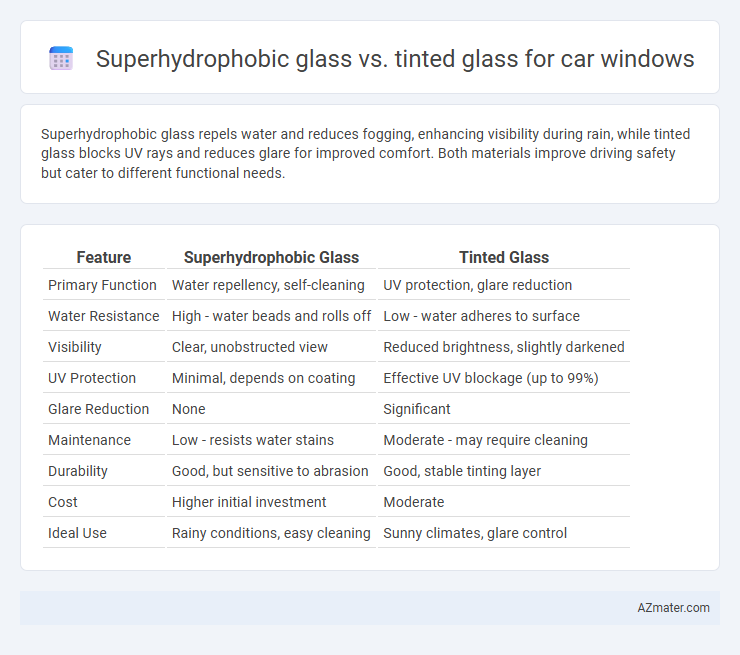Superhydrophobic glass repels water and reduces fogging, enhancing visibility during rain, while tinted glass blocks UV rays and reduces glare for improved comfort. Both materials improve driving safety but cater to different functional needs.
Table of Comparison
| Feature | Superhydrophobic Glass | Tinted Glass |
|---|---|---|
| Primary Function | Water repellency, self-cleaning | UV protection, glare reduction |
| Water Resistance | High - water beads and rolls off | Low - water adheres to surface |
| Visibility | Clear, unobstructed view | Reduced brightness, slightly darkened |
| UV Protection | Minimal, depends on coating | Effective UV blockage (up to 99%) |
| Glare Reduction | None | Significant |
| Maintenance | Low - resists water stains | Moderate - may require cleaning |
| Durability | Good, but sensitive to abrasion | Good, stable tinting layer |
| Cost | Higher initial investment | Moderate |
| Ideal Use | Rainy conditions, easy cleaning | Sunny climates, glare control |
Introduction to Car Window Glass Technologies
Superhydrophobic glass and tinted glass represent advanced car window technologies designed to enhance driving safety and comfort. Superhydrophobic glass uses nanoscale coatings to repel water, improving visibility during rain by preventing water droplets from adhering to the surface. Tinted glass incorporates pigments or films that reduce glare and UV radiation, helping to control cabin temperature and protect passengers from harmful sun exposure.
What is Superhydrophobic Glass?
Superhydrophobic glass features a nanostructured surface that repels water, causing droplets to bead up and roll off effortlessly, enhancing visibility during rain. This advanced coating reduces water spots, dirt accumulation, and improves overall window cleanliness without compromising transparency. Unlike tinted glass, which primarily reduces glare and heat by absorbing sunlight, superhydrophobic glass focuses on water resistance and self-cleaning properties for safer driving conditions.
Understanding Tinted Glass
Tinted glass for car windows reduces glare and UV radiation, enhancing driver comfort and protecting the vehicle's interior from fading. It works by incorporating dyes or metal oxides into the glass, which absorb or reflect specific wavelengths of light while maintaining visibility. Unlike superhydrophobic glass, which repels water to improve visibility during rain, tinted glass primarily focuses on light management and heat reduction inside the car.
Key Benefits of Superhydrophobic Glass
Superhydrophobic glass offers superior water repellency by creating a microscopically textured surface that causes rain to bead and slide off quickly, enhancing visibility during wet conditions and reducing the need for frequent wiper use. This technology significantly minimizes dirt and grime adhesion, leading to easier cleaning and longer-lasting clarity compared to tinted glass, which primarily reduces glare and heat but does not improve water or dirt repellency. Furthermore, superhydrophobic coatings can improve safety by maintaining clearer windows in adverse weather, while tinted glass mainly focuses on UV protection and interior temperature control.
Advantages of Tinted Glass for Vehicles
Tinted glass for vehicles effectively reduces glare and blocks up to 99% of harmful UV rays, enhancing driver comfort and protecting interior materials from fading. It improves privacy and security by obscuring the view into the car while also helping to regulate cabin temperature, leading to better energy efficiency by reducing the need for excessive air conditioning. Compared to superhydrophobic glass, tinted glass offers superior heat rejection and privacy benefits, making it a practical choice for everyday driving conditions.
Durability and Maintenance Comparison
Superhydrophobic glass features a nano-coating that repels water and contaminants, resulting in enhanced durability by reducing surface wear and corrosion compared to tinted glass. Tinted glass primarily offers UV protection and glare reduction but requires regular cleaning and can degrade over time due to exposure to sunlight and weather, leading to discoloration or peeling. Maintenance for superhydrophobic glass is lower since its self-cleaning properties minimize the need for frequent washing, whereas tinted glass demands careful cleaning to preserve the film's integrity and appearance.
Impact on Visibility and Driving Safety
Superhydrophobic glass repels water and dirt effectively, maintaining clearer visibility during rain and adverse weather, which enhances driving safety by reducing glare and the need for frequent wiper use. Tinted glass reduces glare from sunlight and headlights, minimizing eye strain but can decrease visibility in low-light conditions or at night, potentially compromising safety. Both glasses offer distinct benefits; superhydrophobic glass prioritizes consistent clarity in wet conditions, while tinted glass manages light intensity but requires careful consideration of light transmission levels for safe night driving.
Legal Considerations and Regulations
Superhydrophobic glass enhances visibility by repelling water without altering tint levels, often complying with legal limits on window transparency, which vary by jurisdiction but generally require minimum visible light transmission (VLT) of 30-70%. Tinted glass, while providing sun protection and privacy, must adhere strictly to VLT regulations and restrictions on reflectivity defined by local traffic laws to avoid fines or safety hazards. Vehicle owners should verify regional standards set by authorities such as the Department of Transportation or equivalent to ensure both superhydrophobic and tinted glass installations meet legal requirements for on-road use.
Cost Analysis: Superhydrophobic vs Tinted Glass
Superhydrophobic glass typically incurs higher upfront costs compared to tinted glass due to advanced nanoparticle coatings and specialized manufacturing processes. Tinted glass offers a more economical solution, balancing UV protection and heat reduction at a lower price point. Maintenance expenses are generally lower for superhydrophobic glass as its repellent properties reduce cleaning frequency and residue buildup.
Which Glass Option is Best for Your Car?
Superhydrophobic glass offers superior water repellency and improved visibility during rainy conditions, making it ideal for safety-conscious drivers who prioritize clear vision. Tinted glass reduces glare and blocks harmful UV rays, enhancing comfort and protecting the car's interior from sun damage. Choosing between these depends on whether weather resistance or sun protection better suits your driving environment and personal preferences.

Infographic: Superhydrophobic glass vs Tinted glass for Car window
 azmater.com
azmater.com